Trip to the Trinity Site in New Mexico on Oct. 6, 2012
Trip to National Atomic Museum
The White Sands Missle Range was known as the White Sands Bombing Range during
WWII, but the name was changed after WWII, since all the captured V2 rocket
parts were shipped to White Sands after WWII to develop United States missile
technology.
We visited White Sands Missle Range Museum the day prior to visiting the Trinity
Site, but no pics.
Note:
When I worked at ti, my main mentor was Lee Blanton.
Lee was in the Navy at the end of WWII, and near the end of his tour, was
statined at White Sands Bombing Range.
Lee told me story after story of the trials and tribulations of the base as they
assembled V2 rockets from captured German stores, and attempted to mae them fly.
Note:
While at White Sands, Lee worked on Dr. Van Allen's project that used rockets
to discover the Van Allen Belt of radiation around the earth.
Nuther Note:
Special versions of the B-29, called SilverPlate, were built to carry and drop
the two nuclear weapons used in WWII.
More Info about atomic things!
Trip to the Trinity Site on White Sands Missile Range
In October 2012 we went to the WSMR (White Sands Missle Range)'s open house for
the Trinity Site.
We are both interested in WWII and the development and deployment of the atomic
bomb so when I discovered the government was opening the Trinity Site 2 days per
year, we decided to go.
While in NM we also went to the MSMR museum which is VERY INTERESTING and
informative, as I have said else where, my friend and mentor Lee Blanton was in
the Navy at the close of WWII and worked at White Sands on the development of
U.S. missle technology.
Going to the White Sands Missle Range Museum before going to Trinity is a good
idea, it really gave us a better understanding of what they did here.
The scientists working for the government in 1944-45 took a very scientific
theory and really reached beyond what any humans had ever done before to tap a
new form of energy that ended WWII.
The loss of life in Japan was horrific, but the mind set of the group in control
of Japan at the time was to fight to the death of the last man, woman, and child.
I believe that if the Allies had attempted to invade Japan as they had in
Europe, it would have meant an even greater bloodbath than was caused by the
bomb.
I know this is controversial, but I think Harry Truman made the most difficult
decision of any American President in history.
The U.S. government opens up the Trinity Site two days per year for just a few
hours.
These are the only times normal citizens (folks without top military clearances)
can see it even though it is a National Historic Landmark!
I don't blame the government, there is apparantly a lot of secret weapons work
going on here that no one else needs to be aware of.
Even when you are admitted, no one is allowed to just roam around except in this
one confined area.
|
|
Google maps view of the trinity site.
Click on the larger map link below then zoom in, the two dark areas at the
bottom of the almost circular area are the parking lots.
You can see the path leading to the oval area around the acutal blast site.
View Larger Map
|
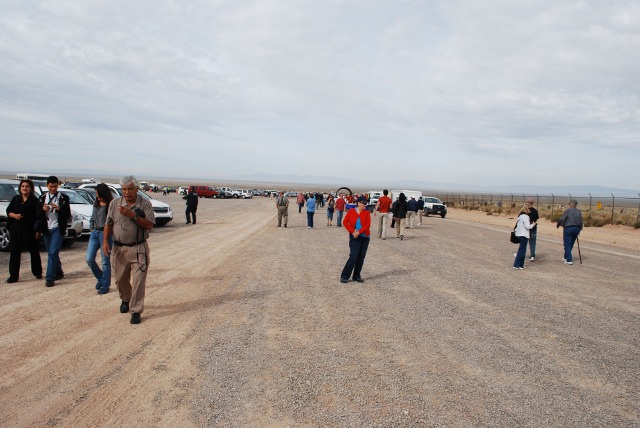
|
Betty getting ready for the walk to the actual blast site.
We though there would only be a handful of folks but there
were several thousand while we were there.
Almost 300 cars were in our caravan and the parking lot
already had 4 times that many.
|
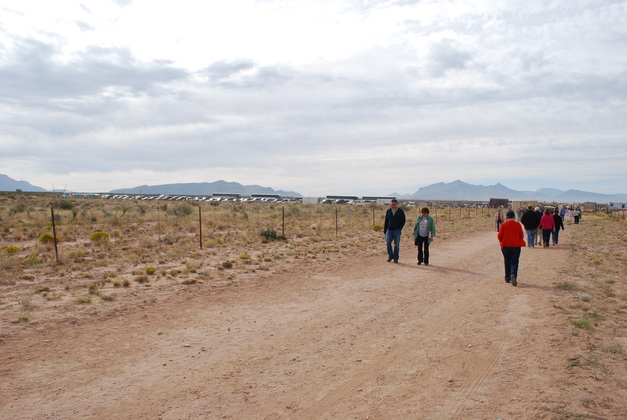
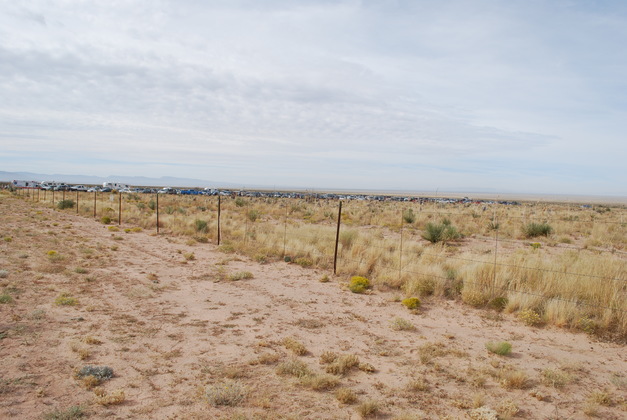
|
These are distant views of the parking lot, we were about 1/4
mile away from the lots.
Click on either pic then click again to get the full effect.
|
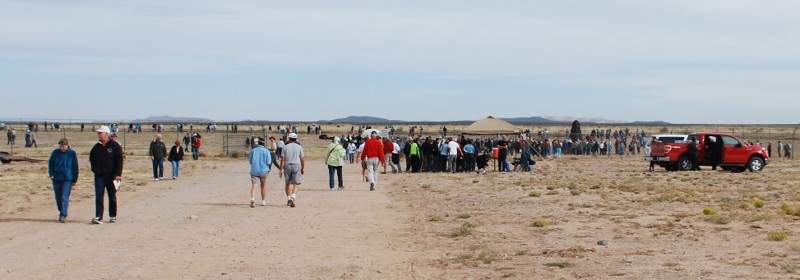
|
As we walked toward the blast site we saw some of
the crowds.
|
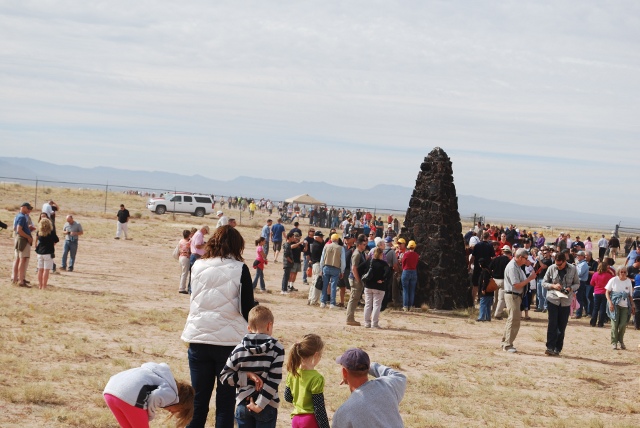
|
Another shot of the crowd around the obelisk marking
the exact spot below the blast.
|
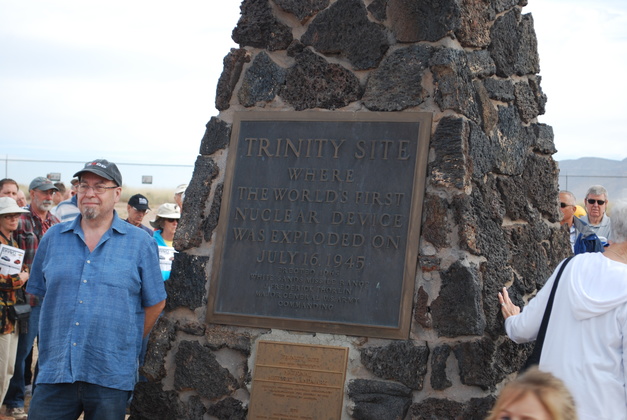
|
Enscription on the obelisk.
Click on the pic, then click again on the brass plaque below.
This is a National Historic Monument, you can only go
there one day per year (due to the Sequester).
|
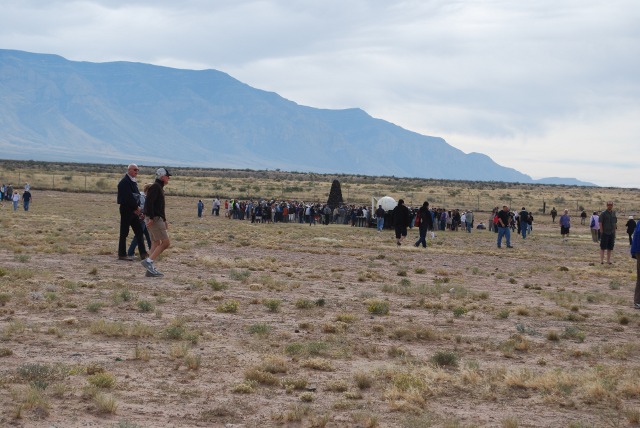
|
Another shot of the crowd around the obelisk from a different
angle.
We were both surprised at how many people were here, there
were almost 300 cars in the caravan from Tularosa and an almost
never ending stream of cars coming in from the Stallion Gate.
|
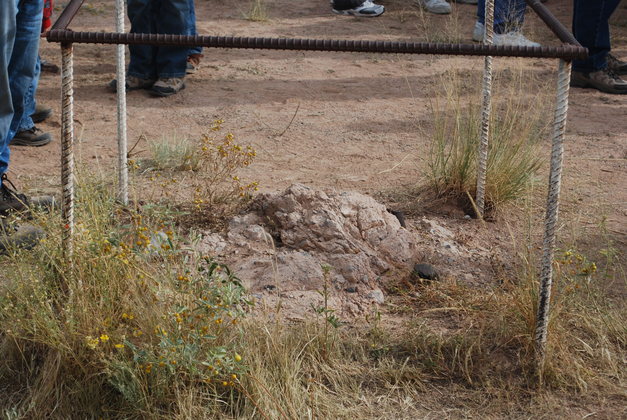
|
One of the footings of the original test tower.
This is all that remains of the test tower that was not vaporized
by the implosion bomb (fat man).
|
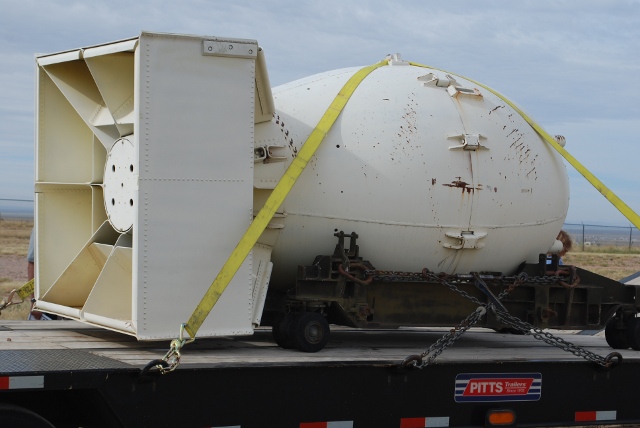
|
A fat man case.
There were two types of bombs built in 1945, Little Boy, a
uranium (gun assembly) bomb, and Fat Man, a plutonium
(implosion) bomb, this detonation was from a plutonium bomb
like Fat Man.
The plutonium bomb in a case just like the one pictured here
(case at National Nuclear Museum), was droppend on Nagasaki (second nuclear bombing of Japan).
The first bomb dropped (on Hiroshima) was like Little Boy
(case at National Nuclear Museum).
They called Fat Man an implosion bomb because of the way the
plutonium was brought to critical mass.
Fat Man was 5 feet in diameter, 10.7 feet long, and weighed
10,213 pounds.
A B-17 could only carry 8,000 pounds, so it had to be dropped
by a B-29
This explosion was the equivalent of about 20 thousand tons
of TNT fueled by a piece of metal a little larger than a
grapefruit.
Look at the hi-rez ground zero sign below for a pic of the
actual test device.
|
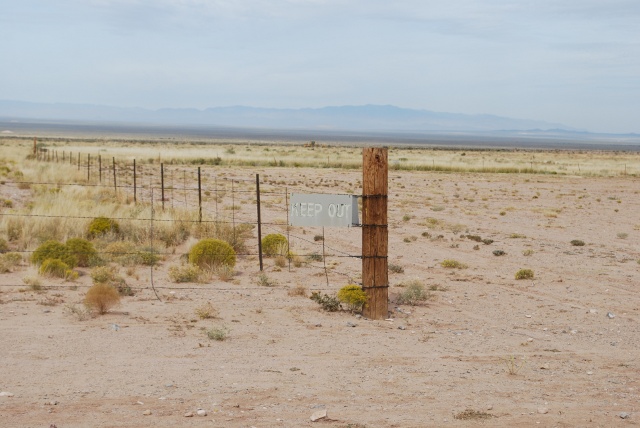
|
This is what the trinity area looks like.
The government keeps visitors in a confined area patrolled by Military Police, unobtrusive, but around.
|
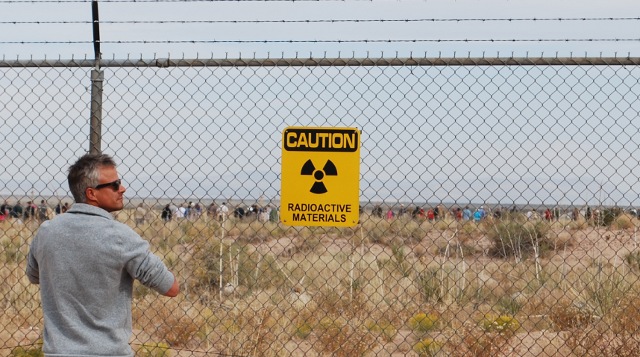
|
There is still radioactivity, this sign is probably more effective that the "Keep Out" sign above.
|
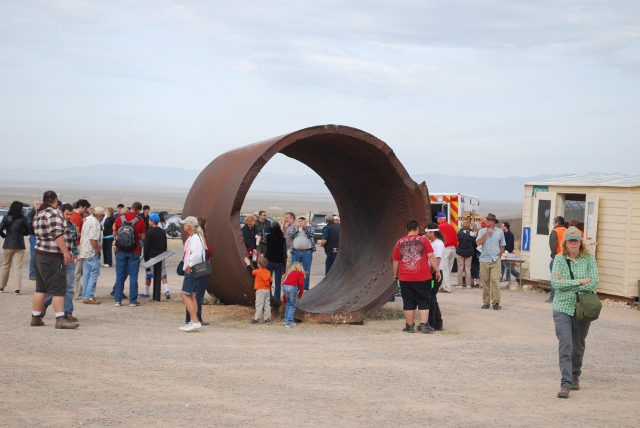
|
This is Jumbo, it was originally built to house the bomb incase the reaction fizzeled, the scientists didn't want to spread nuclear material all over the place.
They later realized that if the bomb detonated it would add to the mass being converted to energy and throw off their calculations, so they decided not to use it since they had confidence in getting a fission reaction.
|
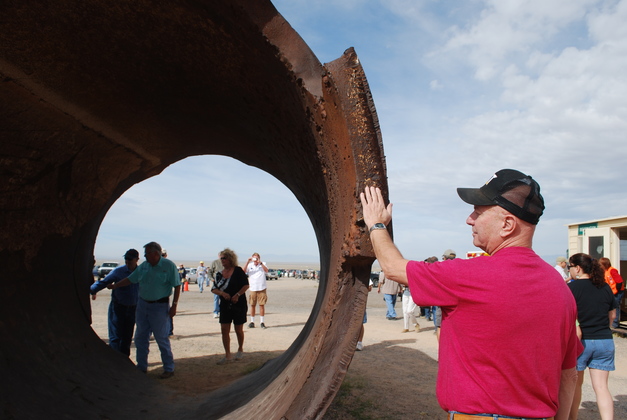
|
A closer look at jumbo, you can see the steel is about 6" thick, and its big enough to stand up in with plenty of head room, note the guys standing at the far end of jumbo.
I'm curious how they broke it??
|
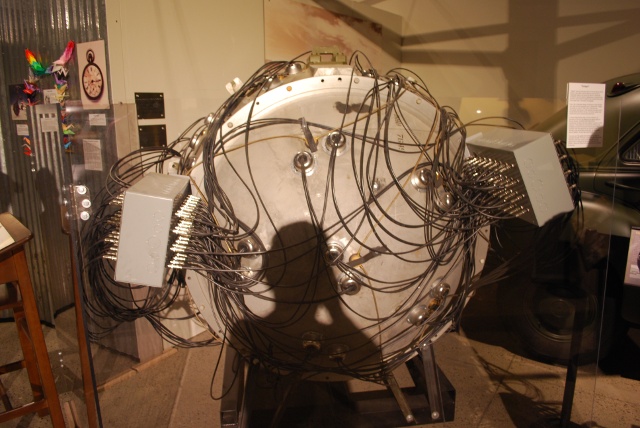
|
This is a mock up of the test device found at Los Alamos and on display at the National Nuclear Museum, it would have to fit inside jumbo.
Remember the core is smaller than a soccer ball (larger than a grapefruit), a hollow spherical sub-critical mass with a smaller solid spherical sub-critical mass inside it.
The outer conventional explosives were in essence a shaped charge that focused inward crushing the outer sperical core onto the smaller solid core creating a critical mass from two sub-critical masses.
It is the large amount of conventional explosives that take up most of the space.
The large number of wires are probably to detonate individual segments of the conventional explosive in sequence.
|
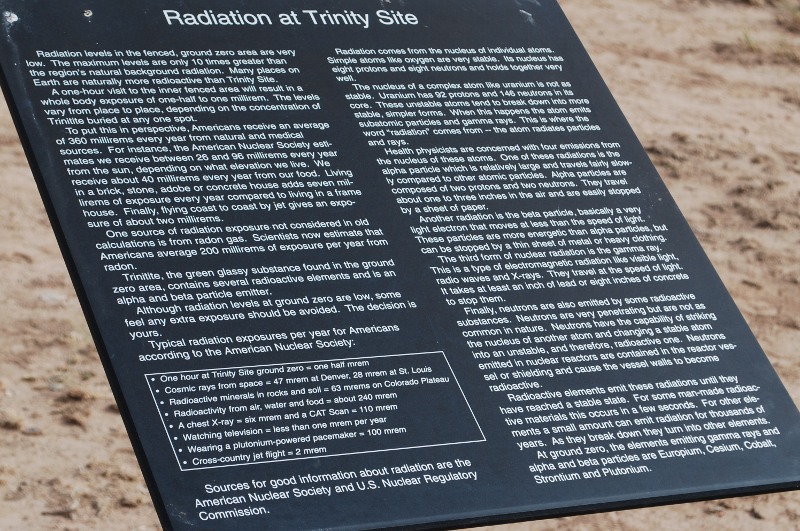
|
Radiation warning, click the picture for a hi-rez shot (some browsers may need to click on the hi-rez to get it to enlarge).
|
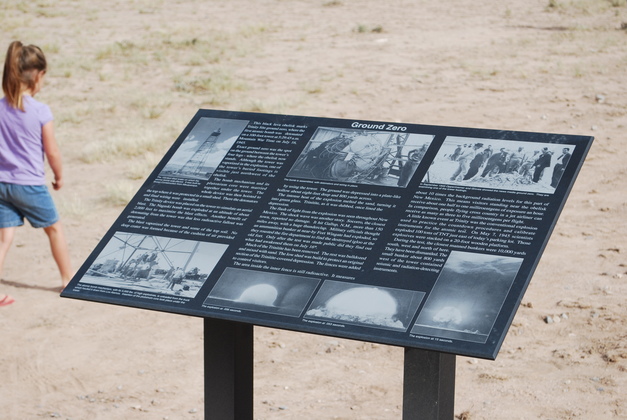
|
The poster explaining a lot about the test device and explosion, click on the pic for hi-rez (some browsers may need to click on the hi-rez to get it to enlarge).
|











